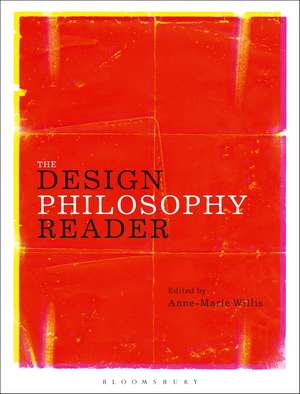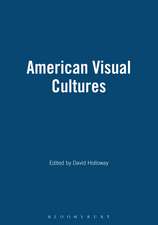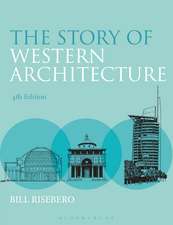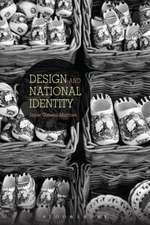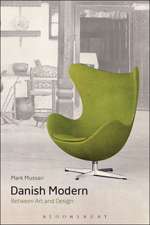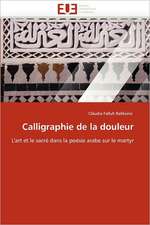The Design Philosophy Reader
Editat de Professor Anne-Marie Willisen Limba Engleză Paperback – 28 noi 2018
| Toate formatele și edițiile | Preț | Express |
|---|---|---|
| Paperback (1) | 256.57 lei 3-5 săpt. | +81.57 lei 10-14 zile |
| Bloomsbury Publishing – 28 noi 2018 | 256.57 lei 3-5 săpt. | +81.57 lei 10-14 zile |
| Hardback (1) | 779.09 lei 6-8 săpt. | |
| Bloomsbury Publishing – 28 noi 2018 | 779.09 lei 6-8 săpt. |
Preț: 256.57 lei
Preț vechi: 308.22 lei
-17% Nou
Puncte Express: 385
Preț estimativ în valută:
49.09€ • 51.40$ • 40.62£
49.09€ • 51.40$ • 40.62£
Carte disponibilă
Livrare economică 15-29 martie
Livrare express 04-08 martie pentru 91.56 lei
Preluare comenzi: 021 569.72.76
Specificații
ISBN-13: 9780857853509
ISBN-10: 0857853503
Pagini: 320
Dimensiuni: 189 x 246 x 26 mm
Greutate: 0.64 kg
Editura: Bloomsbury Publishing
Colecția Bloomsbury Visual Arts
Locul publicării:London, United Kingdom
ISBN-10: 0857853503
Pagini: 320
Dimensiuni: 189 x 246 x 26 mm
Greutate: 0.64 kg
Editura: Bloomsbury Publishing
Colecția Bloomsbury Visual Arts
Locul publicării:London, United Kingdom
Caracteristici
Editorial introductions to extracts help to contextualise and highlight implications for design students
Notă biografică
Anne-Marie Willis is Visiting Professor of Architecture and the Built Environment at the University of Adelaide, Australia and editor of Design Philosophy Papers at The Studio at the Edge of the World.
Cuprins
PrefaceIntroduction, Anne Marie Willis PART 1: THE ESSENCE OF DESIGN Introduction1. The Fault of Epimetheus, Bernard Stiegler 2. In the Beginning, Tony Fry3. A Cautious Prometheus? A Few Steps Toward a Philosophy of Design, Bruno Latour4. The Depth of Design, Albert Borgmann 5. Design as an Ontological Question, Tony Fry Guide to Further Reading PART 2: THE PRACTICE OF DESIGNIntroduction6. Science, Art and Practical Wisdom, Aristotle 7. The Complication of Praxis, William McNeill 8. The Existential Self as Locus of Sustainability in Design, Philippe d'Anjou 9. Science of the Concrete, Claude Levi-Strauss10. The Textility of MakingTim IngoldGuide to Further ReadingPART 3: THE ETHOS OF DESIGN Introduction 11. Artefacts: the Making Sentient of the External World, Elaine Scarry 12. Ethics by Design or the Ethos of Things, Cameron Tonkinwise13. Grievability, Judith Butler14. The One for the Other Adrian Peperrzak15. Ethics in the Making, Bodil Jönsson et alGuide to Further Reading PART 4: DESIGN AND THE OTHER Introduction16. On Coloniality of Knowledge, Madina V. Tlostanova 17. The Enframing Gaze, Timothy Mitchell 18. The Violence of Humanitarian Design, Mahmoud Keshavarz19. The Force of Form, the Effect of Genre, Francois Jullien 20. Why Not an Alphabet? Lothar Ledderose Guide to Further Reading Guide to Further ReadingPART 5: BEING DESIGNED AND THINGSIntroduction 21. The Thing, Martin Heidegger 22. Materialism is Not the Solution: On Matter, Form, and Mimesis Graham Harman23. Is Design Finished? Dematerialisation and Changing Things, Cameron Tonkinwise24. Beyond Affordance Michael May 25. Understanding, Ontology, Thrownness and Readiness-to-hand, Terry Winograd and Fernando Flores26. Smart meters don't make us any smarter Elizabeth Shove and Sarah Royston27. Matter and Mattering or Why are Things "Us"? Clive DilnotGuide to Further Reading PART 6: THE DESIGNING OF TECHNOLOGYIntroduction 28. Technology: Instrumental Metaphor and Cybernetic System, Adrian Snodgrass 29. The Question Concerning Technology, Martin Heidegger30. Technical Mentality, Simondon31. The Finite Framework of Language, Michael Heim32. 'This System Does Not Produce Pleasure Anymore' Bernard StieglerGuide to Further ReadingPART 7: THE DESIGNING OF VISUALITY Introduction 33. Form and Imitation Plato 34. The Plato Effect in Architecture Chistopher N. Henri35. Age of the World Picture, Martin Heidegger 36. An Art Which Imitates Art Pierre Bourdieu37. Sign Function and Class Logic Jean Baudrillard 38. Henri Lefebvre, The Production of SpaceGuide to Further ReadingPART 8: DESIGNING AFTER THE END Introduction39. What is the Anthropolitical? Claire Colbrook40. The Intrusion of GAIA Isobel Stengers41. Cosmoecological Sheep Vinciane Despret and Michel Meuret 42. Outing Artificial Intelligence: Reckoning with Turing Tests Benjamin H. Bratton 43. The Posthuman Rosi Braidotti44. The Sustainment Tony Fry 45. Spinoza and Us Gilles Deleuze Guide to Further Reading BibliographyIndex
Recenzii
In the case of The Design Philosophy Reader, the editor's proficiency as an educator and design scholar becomes evident in how each excerpt is curated for a higher education context. Willis skillfully navigates the limitations of the format and manages to offer a coherent, thought-provoking whole that dynamises the relationships between the selected texts.
More clearly perhaps than any other human science or profession, and in the face of complexly intertwined social, ecological, and cultural crises, design is emerging as a crucial domain of thought and action about life itself. The present is thus an auspicious moment for systematizing a philosophy of, from, and for, design as a strategy for rendering design into a more thoughtful and effectively reconstructive practice. By drawing on both philosophy and the most current strands of critical social theory, The Design Philosophy Reader provides us with the pillars for such a project. I cannot think of anybody more qualified to undertake this task than Anne-Marie Willies, a true pioneer of the design/philosophy interface. In contrast to the much more limited and highly popularized paradigm of design thinking, the Reader demonstrates why the redesigning of design, as the redesigning of the conditions of our collective existence, is the most important intellectual and political project designers and informed citizens can undertake in the current planetary conjuncture.
This is a thoroughly comprehensive text which highlights the connections between philosophy and design. Useful guides to further reading are presented throughout. There is an acceptable balance between older and newer texts, organised into eight distinct parts, together covering an impressively wide range of thinking. Numerous contributors highlight the pervasiveness of design, the current state of thinking and practice of design. This text will be of value to both design theoreticians and practitioners, and should prove to be an essential addition to all design libraries or collections.
The Design Philosophy Reader reminds us that inquiry into the histories and systems that structure 'design' - language, visuality, colonialism, capitalism - must ground our understandings of, and engagements with, it.
Through Willis' astute selection and structuring of key texts, The Design Philosophy Reader offers theoretical apparatus to develop critical thinking within the study and practice of design. It fundamentally opens design to be interrogated and theorized beyond the parameters of professional design and norms within academic design theory today. It will be of interest to anyone interested in questioning design as a condition of existence, and those who seek to problematize the discipline.
Editor Anne-Marie Willis's own practice of 'designing' the Reader is demonstrated in the introduction to this section, where in just two pages the she gives a richly considered, potted-history of philosophy, showing how notions and practices of design and philosophy are mutually implicated... The Reader contains older, essential design-related texts from philosophers such as Claude Lévi-Strauss, Jean Baudrillard, Henri Lefebvre, Martin Heidegger, Gilbert Simondon, and more recent significant thinkers such as Bruno Latour, Bernard Stiegler, Rosa Braidotti, Isabelle Stengers and Judith Butler... The book contains essays that should be required reading for both research and professional work... Willis's curation of the Reader is compelling, not least because she has a critical vision; this is not a sample of work, or just a collection of the great and good.
This book establishes in a very clear way the grounds for research on the philosophy of design. It raises meaningful contradictions that allow postgraduate students to reflect more deeply on their roles as researchers in design. The sections covering designing of visuality and narrative are absolutely brilliant!
More clearly perhaps than any other human science or profession, and in the face of complexly intertwined social, ecological, and cultural crises, design is emerging as a crucial domain of thought and action about life itself. The present is thus an auspicious moment for systematizing a philosophy of, from, and for, design as a strategy for rendering design into a more thoughtful and effectively reconstructive practice. By drawing on both philosophy and the most current strands of critical social theory, The Design Philosophy Reader provides us with the pillars for such a project. I cannot think of anybody more qualified to undertake this task than Anne-Marie Willies, a true pioneer of the design/philosophy interface. In contrast to the much more limited and highly popularized paradigm of design thinking, the Reader demonstrates why the redesigning of design, as the redesigning of the conditions of our collective existence, is the most important intellectual and political project designers and informed citizens can undertake in the current planetary conjuncture.
This is a thoroughly comprehensive text which highlights the connections between philosophy and design. Useful guides to further reading are presented throughout. There is an acceptable balance between older and newer texts, organised into eight distinct parts, together covering an impressively wide range of thinking. Numerous contributors highlight the pervasiveness of design, the current state of thinking and practice of design. This text will be of value to both design theoreticians and practitioners, and should prove to be an essential addition to all design libraries or collections.
The Design Philosophy Reader reminds us that inquiry into the histories and systems that structure 'design' - language, visuality, colonialism, capitalism - must ground our understandings of, and engagements with, it.
Through Willis' astute selection and structuring of key texts, The Design Philosophy Reader offers theoretical apparatus to develop critical thinking within the study and practice of design. It fundamentally opens design to be interrogated and theorized beyond the parameters of professional design and norms within academic design theory today. It will be of interest to anyone interested in questioning design as a condition of existence, and those who seek to problematize the discipline.
Editor Anne-Marie Willis's own practice of 'designing' the Reader is demonstrated in the introduction to this section, where in just two pages the she gives a richly considered, potted-history of philosophy, showing how notions and practices of design and philosophy are mutually implicated... The Reader contains older, essential design-related texts from philosophers such as Claude Lévi-Strauss, Jean Baudrillard, Henri Lefebvre, Martin Heidegger, Gilbert Simondon, and more recent significant thinkers such as Bruno Latour, Bernard Stiegler, Rosa Braidotti, Isabelle Stengers and Judith Butler... The book contains essays that should be required reading for both research and professional work... Willis's curation of the Reader is compelling, not least because she has a critical vision; this is not a sample of work, or just a collection of the great and good.
This book establishes in a very clear way the grounds for research on the philosophy of design. It raises meaningful contradictions that allow postgraduate students to reflect more deeply on their roles as researchers in design. The sections covering designing of visuality and narrative are absolutely brilliant!
